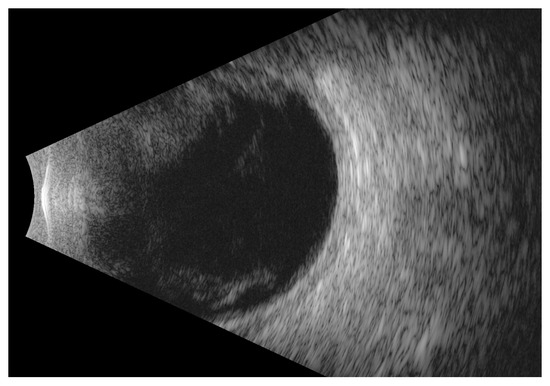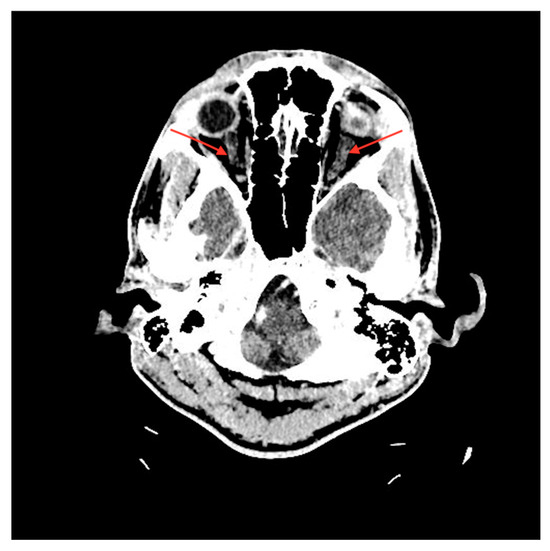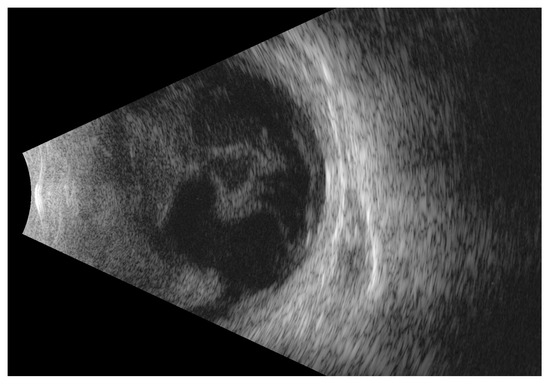Abstract
We present a case of bilateral endogenous endophthalmitis with an extremely rare etiology of Capnocytophaga canimorsus. A 42-year-old asplenic patient with bilateral deterioration of visual acuity presented to the Emergency Department. The sudden deterioration of visual acuity, which prompted the patient to visit the ophthalmologist, was the first sign of the onset of sepsis. The physicians’ attention, in addition to poor visual acuity and intense inflammation on ophthalmologic examination, was drawn to the reported flu-like symptoms. They were accompanied by high C-reactive protein results and abnormalities in echocardiography. A blood culture isolated the bacterium Capnocytophaga canimorsus. Immunocompromised patients are particularly susceptible to C. canimorsus infection. Endophthalmitis of this etiology has a very aggressive course, both ophthalmic and systemic. Therefore, quick diagnosis and initiation of adequate therapy are crucial.
1. Introduction
Capnocytophaga canimorsus is a rare causative pathogen of intraocular infections [1,2]. So far only two cases of bilateral endogenous endophthalmitis of this origin have been described [3,4]. We present the first, to our knowledge, documented case, in which, in addition to inflammatory lesions on the fundus, Roth’s spots were seen.
Endophthalmitis is a vision-threatening ophthalmological emergency. The endogenous form involves pathogen hematogenous spread from the primary focus of the infection. The etiology of C. canimorsus is extremely dangerous with a high mortality rate in sepsis [5,6,7]. Due to rapidly increasing intraocular inflammation and an initially unclear cause, the prognosis of visual acuity is unfavorable [1,2].
2. Case Description
A 42-year-old man with no history of ophthalmic diseases was transferred from another hospital to the Emergency Department (ED) due to significant deterioration of vision in both eyes. At the ophthalmological examination in the ED, the best corrected visual acuity (BCVA) of the right and left eye was finger counting at 50 cm and 20 cm, respectively. Slit-lamp examination demonstrated bilaterally the following: severe irritation, keratic precipitates on the cornea, significant hypopyon in the anterior chamber, posterior synechiae, and fibrin membrane on the lens. Due to intense inflammation seen in the anterior segment of the eyes, the fundus was not visible. The B-scan ultrasonography (USG) showed bilateral optic disc edema and hyperechoic material in the vitreous chambers, mainly in the left eye (Figure 1).

Figure 1.
B-scan ultrasound of the left eye shows hyperechoic material in the vitreous chamber on admission.
The patient had a fever of 38 °C and reported flu-like symptoms (fatigue, muscle aches) with onset a few days earlier. Non-ophthalmic symptoms raised clinical suspicion. He also had an increased risk of infection as he had undergone a splenectomy in the past. Complete blood count (CBC), biochemical tests of blood and urine, HLA antigens, and additional tests for viral and atypical infections were taken. Blood and urine cultures were also performed.
A urine test was positive for amphetamine and marijuana. Laboratory tests revealed high levels of T troponin with an increase up to 2709 pg/mL (reference range: 0–34.2), thrombocytopenia of 36 × 103/μL (reference range: 140–440 × 103), and severely elevated inflammatory parameters including C-reactive protein of 249 mg/l (reference range: 0–5), indicating a suspicion of sepsis. Echocardiography revealed left ventricular hypokinesis and mildly reduced ejection fraction. Cardiologists, after additional tests including coronary computed tomography angiography (CCTA), ruled out an acute myocardial infarction and endocarditis. Myocardial damage was attributed as a secondary sign of ongoing infection. In addition, the thickening of the optic nerve sheaths on computed tomography (CT) was described (Figure 2). A neurologist, after neurological examination along with a head CT, ruled out neuroinfection as the cause of the presented symptoms. Due to the patient’s deteriorating condition, he was admitted to the Department of Internal Medicine.

Figure 2.
CT scan shows symmetrical thickening of optic nerve sheaths (red arrows).
Intravenous broad-spectrum antibiotic therapy, specifically ceftriaxone and vancomycin, was instituted. Within 24 h, there was a progressive decline of vision to hand motion (HM) in front of the eyes. Also, the vitreous exudate, visible on USG scans, increased rapidly (Figure 3). Because of bilateral endophthalmitis with an initially unknown starting point, pars plana vitrectomy (ppV) was performed consecutively on both eyes. The anterior chamber washout was also performed, and the pupil was relieved from posterior synechiae. Samples were taken from the inflamed vitreous for culture. After the removal of the vitreous body, inflammatory and necrotic lesions on the retina with inflammation of the vessel walls were visualized. More intense changes were observed in the right eye. With each day of antibiotic therapy, the patient’s condition improved. A blood culture resulted in the isolation of Capnocytophaga canimorsus—a bacterium normally found in the oral flora of dogs and cats [1]. The moment of infection most likely occurred about a week earlier, when the patient suffered a dog bite—traces of healing wounds were still visible on the fingers of the right hand.

Figure 3.
B-scan ultrasound of the left eye shows progression with a rapid increase in hyperechoic material in the vitreous chamber after 24 h.
After the surgery, insight into the fundus improved (Figure 4a). In the postoperative follow-up, retinal inflammatory changes with intraretinal hemorrhages were seen (Figure 4b). Roth’s spots could be noticed in the peripheral retina. (Figure 4c).

Figure 4.
Fundus photography shows (a) the posterior pole of the right eye image at the first follow-up after vitrectomy. The vitreous chamber was filled with an endotamponade of silicone oil. (b) Intraretinal hemorrhages located outside of the major temporal vascular arcades. (c) Roth’s spots (oval hemorrhages with a central white spot) on the periphery of the retina (red arrows). They are associated with multiple systemic diseases—bacteremia (mostly secondary to infective endocarditis), leukemia, or hypertensive retinopathy.
At the recent check-up, one week after surgery, the BCVA of the better eye was 20/100. Due to a significant improvement in the patient’s condition and normal values of inflammatory parameters, the patient was discharged with further ophthalmological care in the outpatient clinic.
3. Discussion
Sudden loss of vision is an emergency and a challenge in ophthalmologic management—it is only a symptom, which can be associated with multiple conditions. Due to the variety of possible causes, a multidisciplinary approach is often the key to appropriate diagnosis. Neurovascular problems such as neuropathy of the optic nerve due to ischemia or cerebral stroke with blockage of the blood flow to the occipital lobe are a common cause. It may be crucial to perform a neurological examination and brain imaging to identify possible ischemic lesions. In the differential diagnosis, retinal vessel occlusion, retinal detachment, vitreous hemorrhage, ocular injury, infections, or underlying autoimmune diseases with ocular symptoms should be considered. Acute vision loss can also occur as a result of the toxic effects of drugs and metabolic changes [8,9,10].
In the patient described above, uveitis could also be diagnosed due to severe irritation, inflammation of the anterior chamber, and exudate in the vitreous chamber. However, non-ophthalmic manifestations, i.e., elevated inflammatory laboratory markers, elevated body temperature, and immunosuppression due to asplenia, evoke a suspicion of a systemic infectious background.
Endogenous endophthalmitis occurs when microorganisms spread by the blood-borne route and enter the inner spaces of the eye through the blood–eye barrier [11]. It is usually a difficult disease for an ophthalmologist to manage due to the lack of identifiable systemic sources, aggressive progression, and poor clinical prognosis. The endogenous form accounts for only 2–8% of all endophthalmitis cases; the others are those with an exogenous cause. [12].
The worldwide incidence of endogenous endophthalmitis is on the rise. However, difficulties in the ambiguous clinical picture cause delayed diagnosis. The patient may report symptoms of underlying systemic infection such as fever or fatigue in addition to ocular complaints [13]. The ophthalmologic examination reveals decreased blurred vision and red eye [14].
A significant factor in the development of endogenous endophthalmitis in the case of the described patient may have been a history of splenectomy as well as drug abuse. Yet substances administered intravenously were not detected in his urine. Injection drug use (IDU)-associated endogenous endophthalmitis is more common in young men, who do not suffer from comorbidities [15]. Many studies associate the immunosuppression condition with a higher risk of developing endogenous endophthalmitis. However, there is no uniformity on this issue. Among the predisposing factors are diabetes mellitus, organ transplantation, systemic malignancy, human immunodeficiency virus (HIV) infection, or systemic immunomodulatory therapy. Coexisting conditions causing immunosuppression are often associated with a fungal etiology [16,17]. In contrast, there are reports describing that immunosuppression does not significantly increase the risk of developing bacterial endogenous endophthalmitis (BEE). This hypothesis assumes that transplant patients are under constant medical surveillance and may have antibiotic therapy implemented earlier [18].
Patients with bacteremia extremely rarely (0.05%) develop BEE. And only in half of the cases can the infectious agent be identified. The most common pathogens are Streptococcus, Staphylococcus, or Serratia species. Endocarditis is the most frequent disease among other comorbidities which account for BEE [14,18]. Men with bacteriemia without BEE appear to have a higher mortality rate. This may be related to the onset of distressing ophthalmic symptoms, which prompt patients to see a physician sooner.
In the patient described above, C. canimorsus was isolated from the blood. Members of the genus Capnocytophaga are slow-growing, Gram-negative bacilli that rarely cause ophthalmic infections such as keratitis, conjunctivitis, or blepharitis. While some species of Capnocytophaga (C. ochracea, C. gingivalis) belong to the normal human oral bacterial flora, C. canimorsus is usually not found in humans. It forms part of the gingival flora of animals, mostly dogs and cats. The most common way for a human to become infected is through a dog bite, rarely through a cat scratch or close contact with animals. Unlike other Capnocytophaga species, C. canimorsus infection can manifest with several systemic disorders, such as sepsis, meningitis, cellulitis, and endocarditis [1,19].
To date, single cases of bilateral endogenous endophthalmitis of this etiology have been described. Immunosuppression, and especially asplenia, as predisposing factors are emphasized [19,20]. Although C. canimorsus infections most often occur in immunocompromised individuals, they may happen in immunocompetent patients as well [3].
The clinical course of C. canimorsus endogenous endophthalmitis can be very aggressive. It begins with a rapid decrease in BCVA. Slit lamp examination shows significant irritation, cornea with Descemet membrane folds, hypopyon in the anterior chamber, fibrin deposits on the lens, and dense vitritis [2,3]. Interestingly, once the fundus is visualized, choriocapillary infiltration may be revealed [3]. Roth’s spots, which appeared on the retina of the described case, have not yet been described in the clinical picture of this disease entity. However, they were noted in endogenous endophthalmitis of a different etiology [21]. The extraocular prodromal symptoms, such as malaise or fever, may escalate quickly, leading to sepsis with high inflammatory parameters and organ failure. Sepsis of C. canimorsus etiology may be fulminant and fatal [5,6,7].
The accurate therapeutic pathway is difficult to specify, given the small number of cases of endophthalmitis with C. canimorsus etiology. Treatment is initiated empirically after cultures are taken. Sometimes, it is not possible to detect the infectious agent from blood cultures, and thus diagnostic ppV is necessary [2]. Treatment includes intravenous antibiotic therapy and intravitreal injections [3,4]. Intravenous ceftriaxone (1–2 × 2000 mg daily) is usually administered, less often clindamycin (3 × 300 mg) or ciprofloxacin (2 × 400 mg)—it is consistent with C. canimorsus antibiotic susceptibility [2,3,22]. Intravitreal vancomycin (1 mg/0.1 mL) in combination with ceftazidime (2.25 mg/0.1 mL), which are considered the intravitreal treatment of choice for successful management of endophthalmitis as they have a broad-spectrum effect, are most often used. Since the disease can take a very violent course or not improve after conservative treatment, there is a tendency to perform complete ppV [2,3]. Also, in complications of C. canimorsus infection such as retinal detachment or proliferative vitreoretinopathy, ppV is undertaken [1]. After completing the treatment, patients usually experience improvement in visual acuity, but it varies significantly depending on the severity of the disease [2,3,4].
Initially, given the ophthalmic clinical picture resembling uveitis and high CRP, C. canimorsus endophthalmitis can be mistaken for autoimmune inflammation, causing a delay in correct diagnosis and inadequate treatment [3]. Diagnostic difficulties in such a rapidly and severely progressive disease threaten a favorable prognosis for satisfactory visual recovery.
4. Conclusions
Due to the potential risk of serious infection, ophthalmologists should be mindful of the occurrence of C. canimorsus infection, especially in immunocompromised patients. Considering both the sight- and life-threatening complications of C. canimorsus endophthalmitis, early recognition and prompt implementation of appropriate treatment are crucial for positive clinical outcomes.
Author Contributions
Conceptualization, M.Ł. and M.G.; data curation, I.G., J.K. and M.M.-J.; writing—original draft preparation, M.Ł and M.G.; writing—review and editing, R.K. and A.T.-K.; visualization, I.G., J.K. and M.M.-J.; writing—review and editing, R.K. All authors have read and agreed to the published version of the manuscript.
Funding
This research received no external funding.
Institutional Review Board Statement
Not applicable.
Informed Consent Statement
Written informed consent has been obtained from the patient to publish this paper.
Data Availability Statement
No new data were created or analyzed in this study.
Conflicts of Interest
The authors declare no conflicts of interest.
References
- Zimmer-Galler, I.E.; Pach, J.M. Capnocytophaga canimorsus Endophthalmitis. Retina 1996, 16, 163–164. [Google Scholar] [CrossRef] [PubMed]
- Thommen, F.; Opota, O.; Greub, G.; Jaton, K.; Guex-Crosier, Y.; Wolfensberger, T.J.; Matet, A. Capnocytophaga canimorsus Endophthalmitis After Cataract Surgery Linked to Salivary Dog-to-Human Transmission. Retin. Cases Brief Rep. 2020, 14, 183–186. [Google Scholar] [CrossRef] [PubMed]
- Papadaki, T.G.; Moussaoui, R.E.; van Ketel, R.J.; Verbraak, F.D.; Tan, H.S. Capnocytophaga canimorsus Endogenous Endophthalmitis in an Immunocompetent Host. Br. J. Ophthalmol. 2008, 92, 1566–1567. [Google Scholar] [CrossRef] [PubMed]
- Muen, W.J.; Bal, A.M.; Wheelan, S.; Green, F. Bilateral Endophthalmitis due to Dog Bite. Ophthalmology 2009, 116, 1420–1421. [Google Scholar] [CrossRef] [PubMed]
- Hundertmark, M.; Williams, T.; Vogel, A.; Moritz, M.; Bramlage, P.; Pagonas, N.; Ritter, O.; Sasko, B. Capnocytophaga canimorsusas Cause of Fatal Sepsis. Case Rep. Infect. Dis. 2019, 2019, 3537507. [Google Scholar] [CrossRef] [PubMed]
- Handrick, W.; Schwede, I.; Steffens, U. Letal Verlaufende Capnocytophaga-canimorsus-Sepsis Nach Hundebiss. Med. Klin.-Intensiv. Notfallmedizin 2010, 105, 739–741. [Google Scholar] [CrossRef] [PubMed]
- Byard, R.W.; Langlois, N.E. Variable Mechanisms of Dog-Related Deaths. Am. J. Forensic Med. Pathol. 2020, 41, 287–290. [Google Scholar] [CrossRef]
- Newman, N.; Biousse, V. Diagnostic Approach to Vision Loss. Contin. Lifelong Learn. Neurol. 2014, 20, 785–815. [Google Scholar] [CrossRef]
- Basilious, A.; Govas, C.N.; Deans, A.M.; Yoganathan, P.; Deans, R.M. Evaluating the Diagnostic Accuracy of a Novel Bayesian Decision-Making Algorithm for Vision Loss. Vision 2022, 6, 21. [Google Scholar] [CrossRef]
- Prada, L.R.; Knopps, L.; Dumic, I.; Barusya, C.; Subramanian, A.; Charokopos, A.; Zurob, A.S. Transient Complete Blindness Due to Metformin-Associated Lactic Acidosis (MALA) Reversed with Hemodialysis. Am. J. Case Rep. 2022, 23, e935730. [Google Scholar] [CrossRef]
- Reedy, J.S.; Wood, K.E. Endogenous Pseudomonas aeruginosa Endophthalmitis: A Case Report and Literature Review. Intensiv. Care Med. 2000, 26, 1386–1389. [Google Scholar] [CrossRef] [PubMed]
- Rishi, E.; Maitray, A.; Rishi, P.; Gopal, L.; Bhende, P.; Ray, R.; Therese, K.L. Endogenous Endophthalmitis in Children and Adolescents: Case Series and Literature Review. Indian J. Ophthalmol. 2019, 67, 795–800. [Google Scholar] [CrossRef] [PubMed]
- Xie, C.A.; Singh, J.; Tyagi, M.; Androudi, S.; Dave, V.P.; Arora, A.; Gupta, V.; Agrawal, R.; Mi, H.; Sen, A. Endogenous Endophthalmitis—A Major Review. Ocul. Immunol. Inflamm. 2023, 31, 1362–1385. [Google Scholar] [CrossRef] [PubMed]
- Durand, M.L. Endophthalmitis. Clin. Microbiol. Infect. 2013, 19, 227–234. [Google Scholar] [CrossRef] [PubMed]
- Ciociola, E.C.; Powell, J.C.; Barnwell, E.; Zehden, J.A.; Robbins, C.B.; Soundararajan, S.B.; Singh, P.; Zhang, A.Y.; Fekrat, S.M.F.; Greven, M.A. Endogenous Endophthalmitis Associated with Injection Drug Use Compared with Other Etiologies. Retina 2023, 43, 1996–2002. [Google Scholar] [CrossRef] [PubMed]
- Huth, A.; Viestenz, A.; Heichel, J.; Gabel-Pfisterer, A. Endogene Candida-Endophthalmitis: Diagnostik und Therapieoptionen anhand von Fallbeispielen. Die Ophthalmol. 2024, 121, 291–297. [Google Scholar] [CrossRef] [PubMed]
- Balamurugan, S.; Khodifad, A. Endogenous Fusarium Endophthalmitis in Diabetes Mellitus. Case Rep. Ophthalmol. Med. 2016, 2016, 6736413. [Google Scholar] [CrossRef] [PubMed]
- Budoff, G.; Thangamathesvaran, L.; Zarbin, M.A.; Bhagat, N. Bacterial Endogenous Endophthalmitis in Bacteremic Inpatients. Ophthalmol. Retin. 2019, 3, 971–978. [Google Scholar] [CrossRef] [PubMed]
- Lion, C.; Escande, F.; Burdin, J. Capnocytophaga canimorsus Infections in Human: Review of the Literature and Cases Report. Eur. J. Epidemiol. 1996, 12, 521–533. [Google Scholar] [CrossRef]
- Rossi, P.; Oger, A.; Bagneres, D.; Frances, Y.; Granel, B. Capnocytophaga canimorsus Septicaemia in an Asplenic Patient with Systemic Lupus erythematosus. BMJ Case Rep. 2009, 2009, bcr0520091840. [Google Scholar] [CrossRef]
- Chuang, L.H.; Song, H.S.; Lee, S.C.; Lai, C.C.; Ku, W.C. Endogenous Klebsiella pneumoniae endophthalmitis associated with prostate abscess: Case report. Chang Gung Med. J. 2000, 23, 240–245. [Google Scholar] [PubMed]
- Phipps, E.S.; Tamblyn, D.M.; Badenoch, P.R. Capnocytophaga canimorsus endophthalmitis following cataract surgery. Clin. Exp. Ophthalmol. 2002, 30, 375–377. [Google Scholar] [CrossRef] [PubMed]
Disclaimer/Publisher’s Note: The statements, opinions and data contained in all publications are solely those of the individual author(s) and contributor(s) and not of MDPI and/or the editor(s). MDPI and/or the editor(s) disclaim responsibility for any injury to people or property resulting from any ideas, methods, instructions or products referred to in the content. |
© 2024 by the authors. Licensee MDPI, Basel, Switzerland. This article is an open access article distributed under the terms and conditions of the Creative Commons Attribution (CC BY) license (https://creativecommons.org/licenses/by/4.0/).